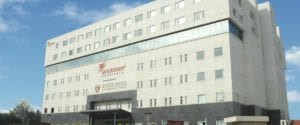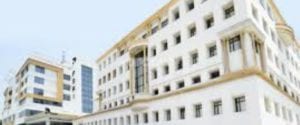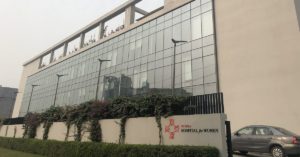Best Doctors in India for Jaw Surgery
Best Hospitals in India for Jaw Surgery
S L Raheja Hospital, Mahim, Mumbai
- City: Mumbai, India
Hospital Highlights:
- SL Raheja hospital is a 140-bed multi-specialty tertiary care hospital that is being managed by Fortis Healthcare Ltd.
- The hospital is a benchmark in healthcare and medical facilities in the neighborhood of Mahim & the western suburbs.
- L.Raheja Hospital, Mahim has one of the most effective ICU and Casualty care services.
- The hospital provides specialty medical services in Cardiology, Oncology, Neurology, Orthopedics, Mother & Child Care, and in Diabetes.
Wockhardt Hospitals, Mumbai
- City: Mumbai, India
Hospital Highlights:
- Wockhardt Hospitals were established in the year 1973, originally called First Hospitals and Heart Institute.
- Wockhardt Hospitals are super specialty health care networks in India, nurtured by Wockhardt Ltd, India’s 5th largest Pharmaceutical and Healthcare company.
- Wockhardt Hospitals is associated with Partners Harvard Medical International, an international arm of Harvard Medical School, USA.
- Wockhardt Heart Hospital performed India’s first endoscopic heart surgery.
- The hospital has a state-of-the-art infrastructure equipped with the latest technologies and modern equipment.
- It has special Centers of Excellence dedicated to the major specialties to provide hassle-free and high-quality clinical care.
Pushpawati Singhania Hospital & Research Institute, New Delhi
- City: New Delhi, India
Hospital Highlights:
- Established in 1996, Pushpawati Singhania Research Institute is one of the top hospitals in the NCR region, as well as one of the top facilities in India for gastroenterology. The hospital is one of South Asia’s first institutes in medical and surgical treatment for diseases related to digestion.
- The hospital is equipped with state-of-the art facilities coupled with the latest equipment as well as renowned consultants from various parts of India as well as other parts of the world.
W Pratiksha Hospital, Gurgaon
- City: Gurugram, India
Hospital Highlights:
- W Pratiksha Hospital, Gurugram, is one of the best hospitals in the NCR region. It is also a top hospital in India for IVF. Since its inception, the hospital has performed over 5500 successful IVFs. The hospital also specializes in gynecology.
- With over 20 years of experience in providing quality healthcare, the hospital is known as one of the most trusted and valued health providers in India.
- Equipped with world-class medical facilities and advanced technology, the hospital’s doctors and clinicians also have a track record of delivering excellent results. The hospital is also known for focusing on preventive well-being as much as on curative treatment.
- The hospital has earned the trust of its patients, by providing the best available treatments at affordable costs.
Narayana Superspeciality Hospital, Gurugram
- City: Gurugram, India
Hospital Highlights:
- Situated near DLF Cyber City, Gurugram, Narayana Superspecialty Hospital is one of the top medical facilities in the Delhi NCR region, catering to the needs of the people. Known for its commitment to quality medical care and patient service, the hospital is a state-of-the-art facility with planned and well-equipped sections, which includes a spacious OPD area as well as comfortable patient rooms.
- It is the closest super-specialty hospital from Indira Gandhi International Airport towards Gurugram, and also the nearest super specialty hospital from DLF Cyber City. It is also close to major residential areas in Gurugram.
- It is part of the renowned Narayana Health Group. Established in 2000, by Dr. Devi Shetty, a renowned cardiac surgeon, it has grown to be one fo India’s leading healthcare groups.
Sir Ganga Ram Hospital, New Delhi
- City: New Delhi, India
Hospital Highlights:
- Sir Ganga Ram Hospital, New Delhi is known to provide the latest medical procedures with the latest technology in all of its units.
- The hospital has a team of reputed doctors, nurses, and healthcare professionals that ensure that patients receive quality care at affordable costs.
- Staffed with a team of highly qualified doctors, dedicated nurses, and paramedical and non-medical staff, the hospital aims to lead in healthcare delivery, medical education, training, and research.
- As per the vision of the founder, the hospital also provides free treatment to the economically weaker sections of society.
- Sir Ganga Ram Hospital also provides training to young doctors under the Diplomate in National Board(DNB) program. The DNB program at the hospital was started in 1984 and it is known for currently running the maximum number of DNB specialties in the country. It also has the distinction of having the first bone bank in India.
CK Birla Hospital, Gurugram
- City: Gurugram, India
Hospital Highlights:
- The CK Birla Hospital in Gurugram is a NABH-accredited multi-specialty hospital.
- The hospital strives to increase the quality of healthcare by focusing on UK NHS nurse and midwife training requirements. Policies and practices derived from the National Institute for Health and Treatment Excellence (NICE) recommendations in the United Kingdom ensuring that a strong focus on safety, high-quality clinical care, and sanitation is maintained.
- The hospital’s cutting-edge technology and facilities allow for real-time communication and seamless collaboration among caregivers, ensuring accuracy and the best possible results. Those with foreign experience and accreditations make up part of the hospital’s team of clinicians.
KIMS Hospital, Hyderabad
- City: Hyderabad, India
Hospital Highlights:
- KIMS Hospital (a brand name of Krishna Institute of Medical Sciences) is one of the largest and best multi-speciality hospitals in Hyderabad. The hospital provides various treatments to an enormous number of patients.
- The hospital has a capacity of more than 3000 beds. KIMS Hospitals offers different healthcare services in more than 25 specialities and super specialities.
- The hospital is equipped with modern medical equipment and technology. It has robotic equipment to provide minimal invasive techniques for patients.
- The hospital is aimed at providing world-class healthcare facilities and services at an affordable cost for patients.
- The various specialities and departments of the hospital include neurosciences, gastroenterology & hepatology, robotic science, reproductive sciences, dental science, oncological sciences, organ transplantation, heart and lung transplantation and mother and child care.
Fortis Hospital, Shalimar Bagh
- City: New Delhi, India
Hospital Highlights:
- Fortis Hospital in Shalimar Bagh is a multi-super specialty hospital that strives to provide world-class patient care by leaving no stone unturned.
- Fortis, Shalimar Bagh, with 262 beds and a 7.34-acre footprint, provides the best level of medical care through its team of doctors, nurses, technicians, and management professionals.
Reliance Hospital, Mumbai
- City: Mumbai, India
Hospital Highlights:
- Reliance Hospital is one of the best super-specialty care hospitals in Navi Mumbai.
- The main purpose of this hospital is to become a trustworthy place for the best health and hope for society. The hospital is well connected to the suburbs of Mumbai and Navi Mumbai.
- The hospital has various specialty departments, viz., Accident & Emergency, Anesthesiology, Dental Services, Dermatology, Diabetology, Dietetics Nutrition, Endocrinology, ENT, Gastroenterology, General Surgery, Gynaecology And Obstetrics, Hepato Pancreato Biliary Surgery, Infectious Disease, Internal Medicine, Interventional Radiology, Laboratory Medicine, Minimal Access Laparoscopic Surgery, Nephrology, Neurosciences, Opthalmology, Orthopaedics, Paediatrics, Pain Management Palliative Care, Physical Medicine Rehabilitation, Plastic And Reconstructive Surgery, Psychiatry, Pulmonary Medicine, Radiology, Rheumatology, Transplant, Urology Andrology, Vascular Surgery
Jaw Surgery
Jaw surgery also termed as orthognathic surgery, is performed to connect irregularities of the jaw bones to realign the jaws and teeth for improvement in the way they work. Making these connections can also help in improving your facial appearance.
Jaw surgery is often considered as an option if you are facing jaw problems that can’t be addressed with orthodontics. Sometimes you also need braces on your teeth before and after surgery until healing and the alignment is done. To determine your treatment plan, your orthodontist will need to work with your oral and jaw and face surgeon.
The appropriate time for conducting jaw surgery is usually after growth stops, which is ages 14 to 16 for females, and ages 17 to 21 for males.
Purpose
Jaw surgery is considered to help with several factors such as:
- Adjusting your bite, which is how your teeth fit together when you close your mouth
- Correcting conditions that can affect your face’s symmetry
- Repairing injuries or congenital conditions that involve the face, such as a cleft palate
- Help easing pain caused by a temporomadibular joint disorder
- Helping prevent further wear and tear to the teeth
- Making it easier to bite, chew and swallow
- Addressing breathing problems, like obstructive sleep apnea or mouth breathing
Preparation
Generally, in most cases, an orthodontist puts braces on your teeth before the surgery is performed. Braces are usually on for 12 to 18 months before the surgery is performed in order to help in leveling and aligning your teeth.
Your orthodontist will work together with your maxillofacial surgeon to develop a treatment plan. X-rays, pictures and models of your teeth are part of the planning for the surgery. On some occasions, the difference in the way that the teeth fit together can require either reshaping of the teeth, covering the teeth with crowns or both to finish the correction.
Sometimes to help in the movement of teeth, three-dimensional CT scanning, computer-guided treatment planning and temporary orthodontic anchoring devises might be used. In some cases, these efforts might even completely eliminate the need for a jaw surgery.
Sometimes, virtual surgical planning can and will be used to guide your surgeon to fit and correct the jaw segment position during the procedure to help achieve the most optimal result.
Procedure
Surgical procedures can usually be performed inside the mouth, therefore, no facial scars will show up on your chin, jaw or around your mouth. However, once in a while, there might be a requirement for small incisions outside your mouth.
Your surgeon will make the cuts in the jawbones after which he will move them to the right position. After the development of the jaw is completed, miniscule bone plates, screws wires and elastic bands can be utilized to make sure that the bones are secured properly in the new positions.
At times, an additional bone might have to be added to the jaw. Your surgeon will move the bone from your hip, rib or leg and protect it with plates and screws. In some cases the bone can be reshaped as well, to give it a superior fit.
Jaw surgery is performed on the upper jaw, lower jaw, chin and sometimes any combination of these.
Upper Jaw
Surgery which is performed on the upper jaw is meant to correct:
- Significantly receded or protruding upper jaw
- Crossbite
- Open bite
- Too little or too much of the teeth showing
- Reduced facial growth in the middle of the face
Your surgeon will cut the bone over your teeth with the aim that the whole top jaw which includes the top of your mouth as well as your upper teeth should move out as one unit. The jaw and upper teeth are moved ahead until they can fit appropriately with the lower teeth. This can be planned using a computer, to determine if additional work such as orthodontics will be required to help correct any remaining fit difference.
An open bite will occur when excess bone growth occurs above the jaw, which will cause what’s normally a flat even surface to become angled. In order to fix this, your surgeon can shave away or remove the excess bone.
Once the jaw has been realigned, plates and screws can hold the bone in its new position.
Lower Jaw
A lower jaw surgery can help to connect:
- Receding lower jaw
- Protruding lower jaw
Your surgeon makes the cuts at the back of the molars as well as lengthwise down the jawbone. Due to this, the the front of the jaw can move as one unit. After this, the jaw can be moved to its new position, which can be forward or backward. Plates can help in holding the jawbone together while it is healing.
Chin surgery
A chin surgery or genioplasty is used to correct a small or deficient chin, which often accompanies a severely receded lower jaw. Surgeons can alter the jaw, and then restructure the chin during one single surgery. The surgeon first cuts one piece of the chin bone on the front of the jaw, moves it forward, after which he secures it in a new position with the help of plates and screws.
Post-Surgery
Majority of people usually remain in the hospital for 1 to 4 days after completing the procedure.
When you’re at the point where you’re ready to leave, you’ll be given guidlines for your meals as well for maintaining oral cleanliness. It is also quite important that you adhere to these guidelines cautiously during recuperation.
After your surgery, it is also possible that you will encounter swelling, stiffness or inconvenience in your face and jaw. These problems ought to disappear within some time. Your doctor will provide you prescriptions in order to help with these side effects.
From time to time, you might also encounter numbness in your top or base lip. This is typically temporary and should disappear over some weeks or months. In some uncommon cases, it can be lasting.
Recovery can take somewhere between 6 to 12 months. After some weeks of recovery, your orthodontist will continue adjusting your teeth using braces. After the braces are removed, your orthodontist will provide you with a retainer which will help in keeping your teeth aligned.
Risks
Jaw surgery is generally safe when it is performed by an accomplished oral and maxillofacial surgeon, often collaborated with an orthodontist. Still, there are risks associated with this surgery, which can include:
- Blood loss
- Contamination
- Nerve injury
- Jaw relapse back to the original place
- Jaw break
- Issues regarding bite fit and jaw joint plan
- Requirement for additional surgery
- Requirement for root canal treatment on selected teeth
- Loss of a jaw portion
After the surgery, you might go through:
- Pain and swelling
- Issues with eating which can be addressed by nutritional supplements
- A short time of adjustment to another facial appearance











